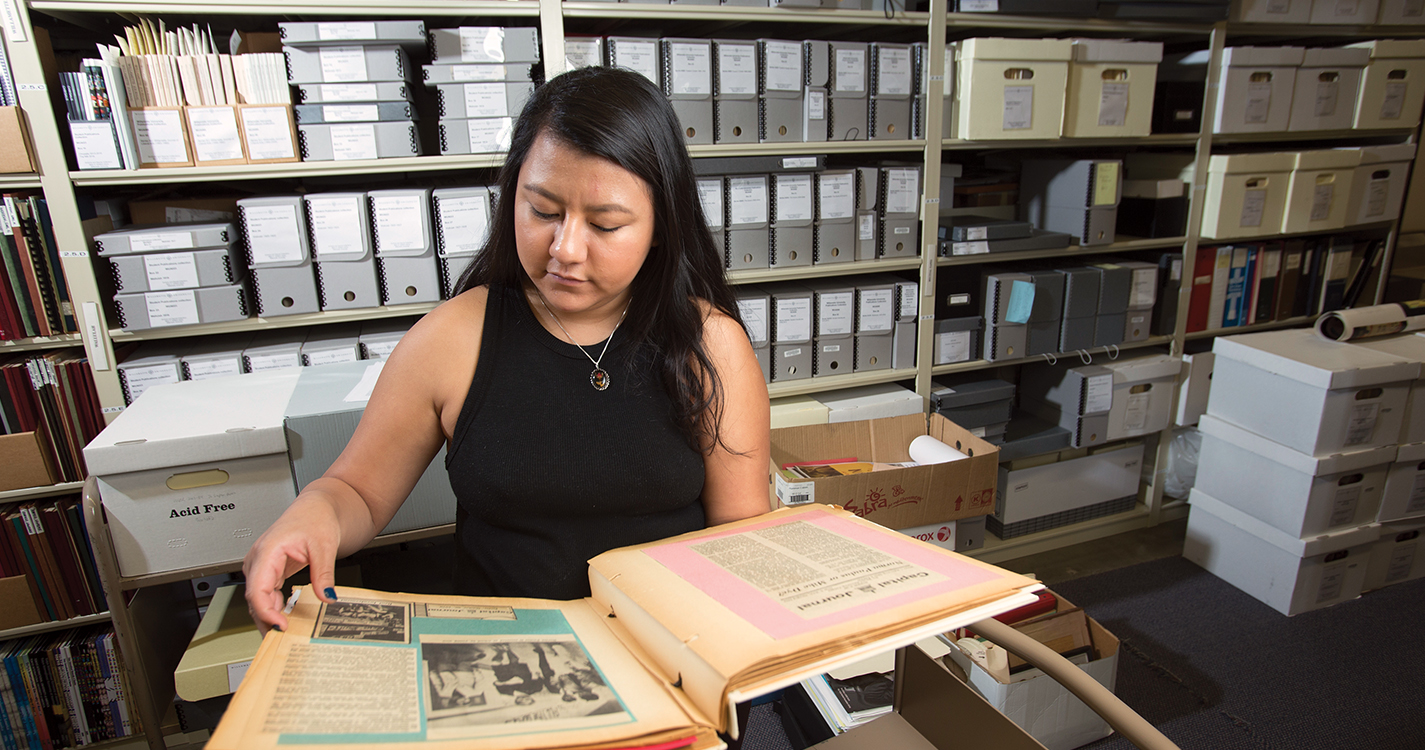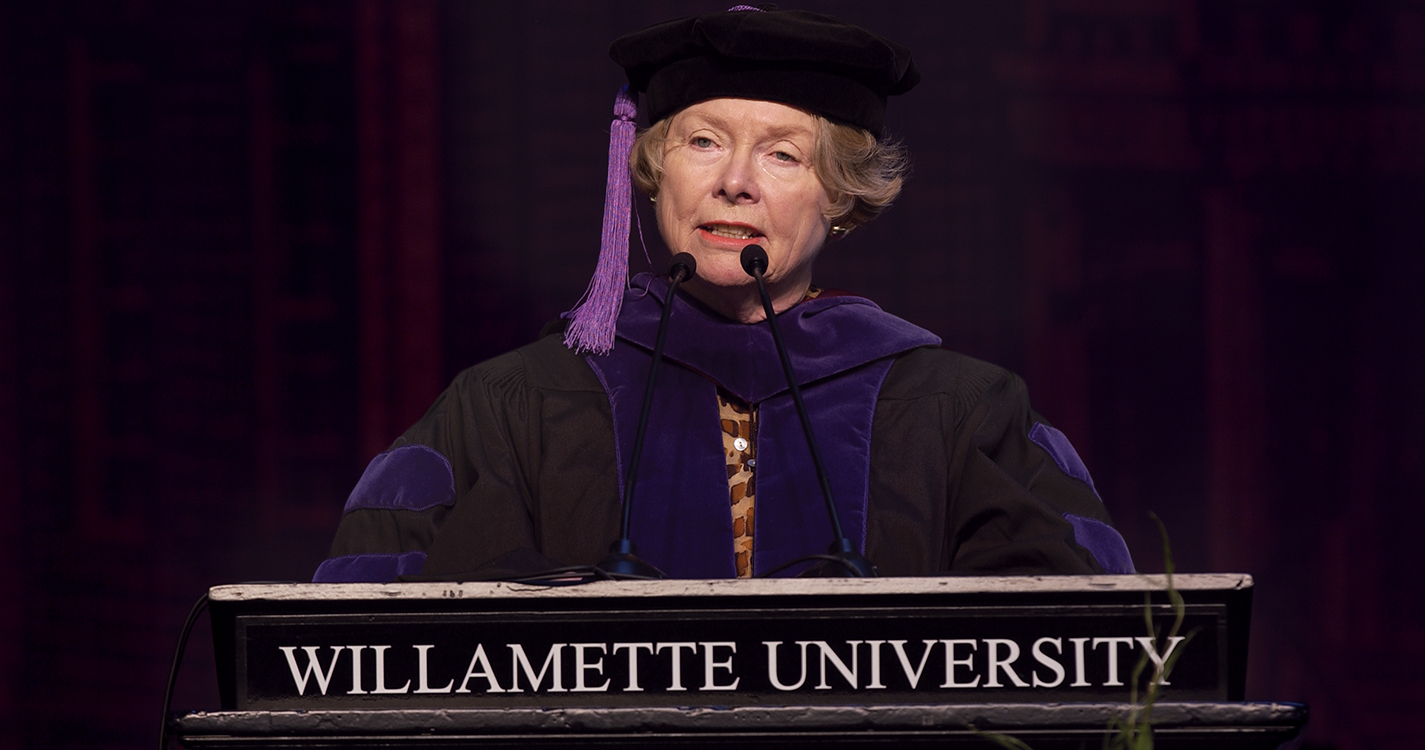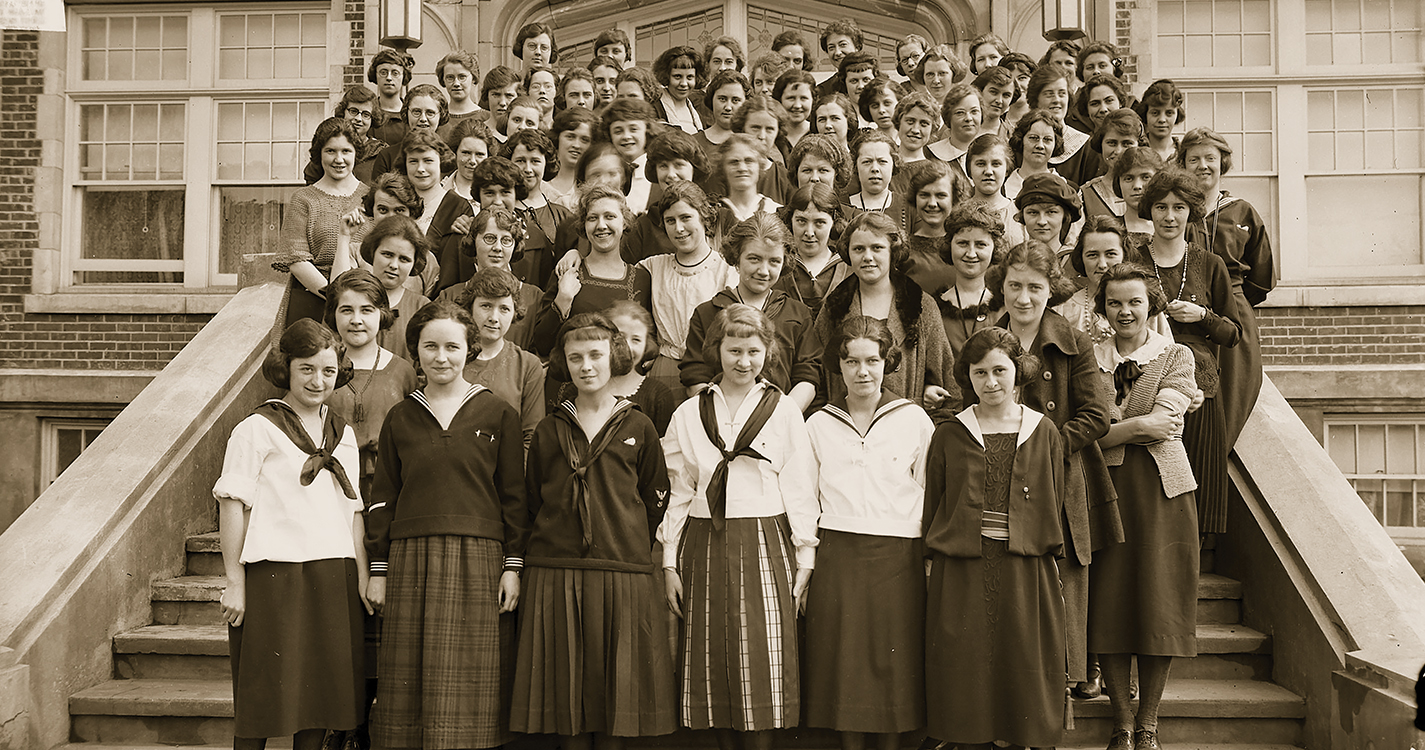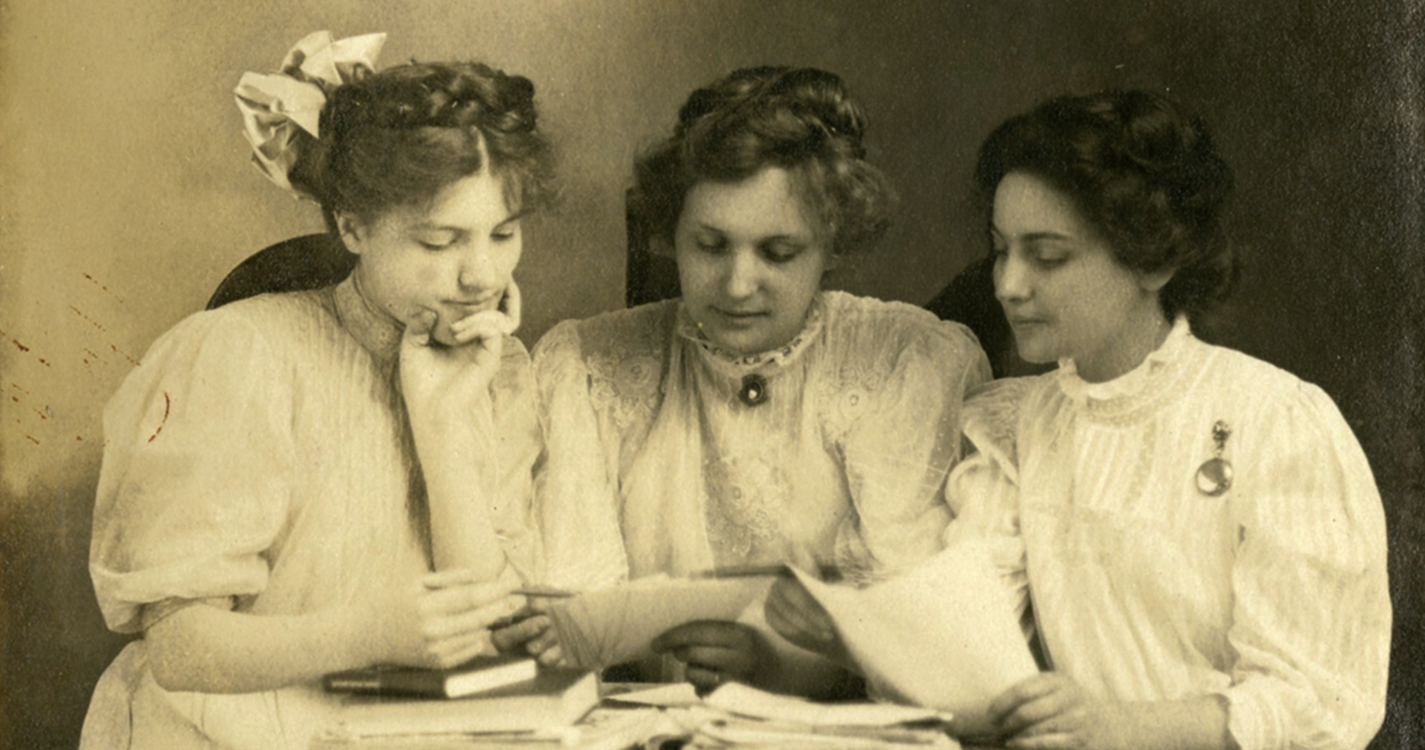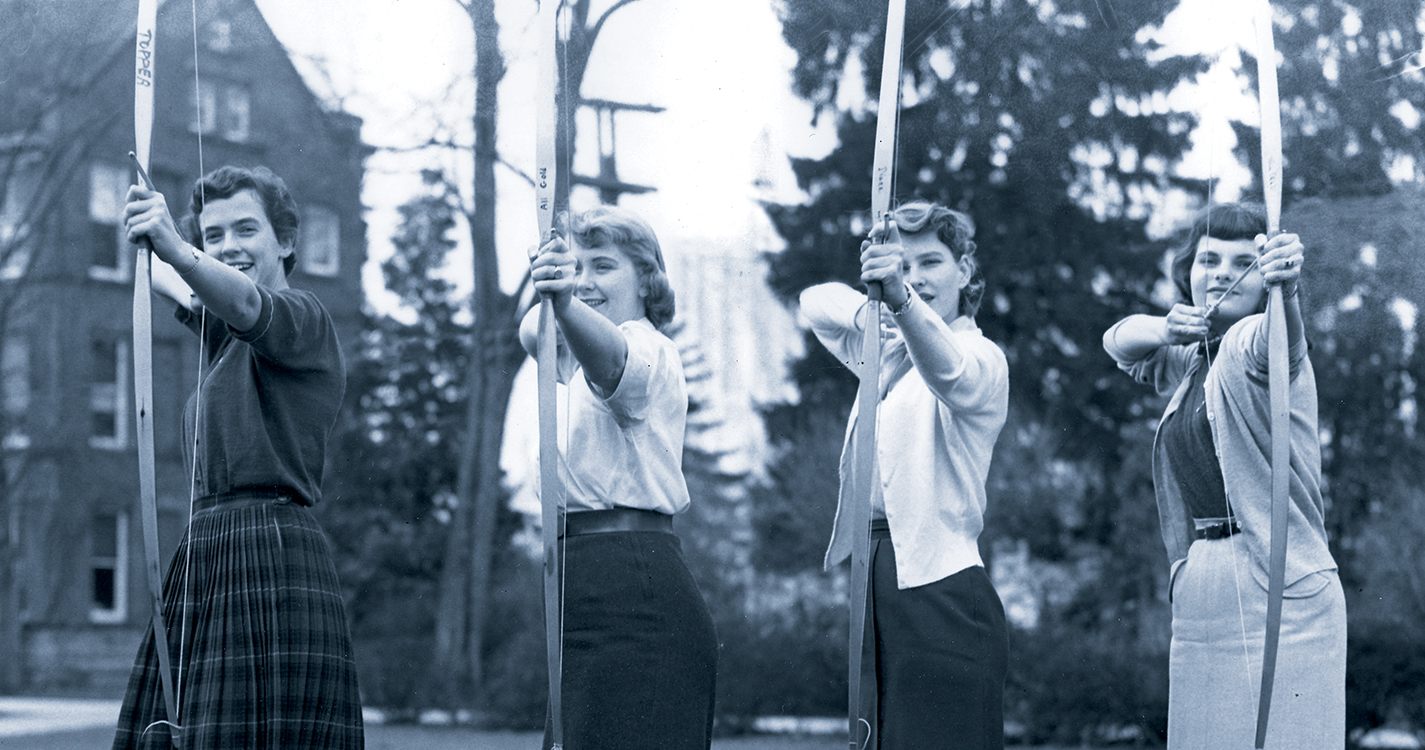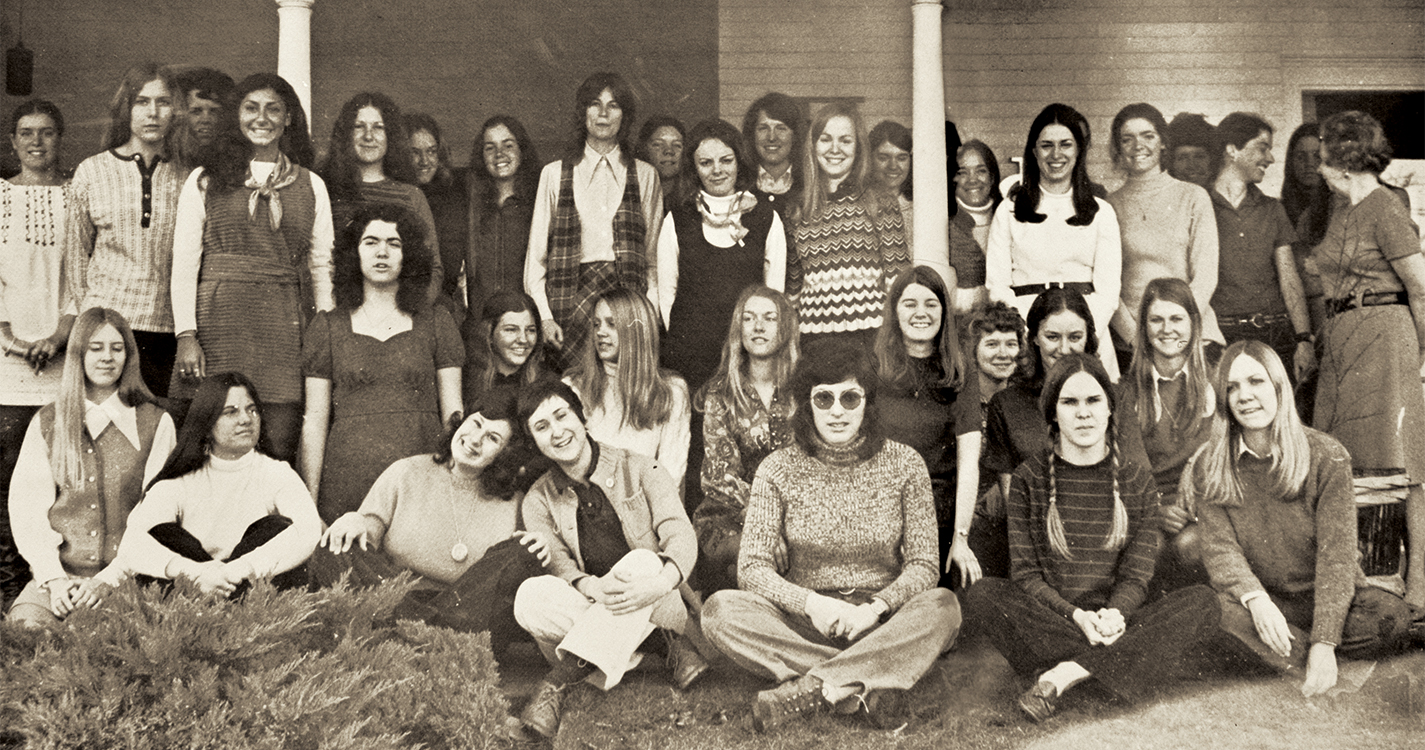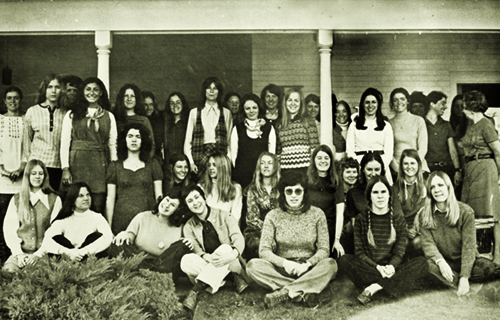When Sidney Gallardo ’17 took a tour of the Willamette University Archives in 2015, she didn’t suspect that she would end up immersing herself in the life of one of Willamette’s most accomplished women.
But archivist Mary McRobinson had told the visiting group of students that she needed help with several projects, and the story of Norma Paulus (pictured below) piqued Gallardo’s interest.

Willamette admitted Paulus into its law school in 1956, when she was a legal secretary for Oregon Supreme Court Justice Earl C. Latourette. She had no prior college experience, but excellent test scores. After graduating with her law degree in 1962, Paulus went on to a stellar career in Oregon politics. Elected as Oregon’s first female Secretary of State in 1976, she became the Republican candidate for governor in 1986 and Oregon Superintendent of Education in 1990.
Gallardo discovered these and many other impressive details about Paulus’ life as the history department archival intern in 2016. For an entire semester, she spent several hours a week hunkered among hundreds of Paulus’ photos, wearing white gloves to avoid fingerprinting the images and struggling to decipher the handwriting scrawled on their backs. Norma during her second term as Secretary of State, flinging her arms in the air as she celebrated her 15 years in state government. Norma at a quilting circle in 1986 during her run for governor. Norma on a fishing boat during that same campaign, smiling into the drizzle.
Although Gallardo had never heard of Paulus before the archives tour — and even though they’ve never met in person — she now calls her “Norma” with the pride and familiarity of a close friend. And she’s shocked at the extent to which Paulus’ story is missing from most accounts of Oregon’s history.
“I had a two-foot-high pile of books, and there was hardly any mention of Norma or any other women,” says Gallardo, who wrote a thesis called “‘She Flies on Her Own Wings’: Women as Key Political Actors in the Oregon Story.” “I was so frustrated because I was fascinated by Norma and knew she wasn’t being credited for her accomplishments. We make a big mistake when we write history and leave the women out.”
Here from the beginning
Unlike many historic colleges and universities that were founded as men’s institutions and only later admitted women, Willamette opened its doors to both male and female students from the beginning.
Willamette’s first graduate, in 1859, was a woman named Emily York. One 1905 history of the university even claims that York was the first college graduate on the West Coast. York herself once quipped, “As I was the only graduate, I was the valedictorian.”
In 1863, the university graduated six men and six women. One year later, four women and three men made up the class of 1864 — the first of many such instances throughout Willamette’s history when female graduates outnumbered males. Somewhat downplaying this enlightened leap in women’s education, Willamette professor and historian Robert M. Gatke explained in his 1943 “Chronicles of Willamette: The Pioneer University of the West” that the school was only coed because of practical necessity rather than choice: The resources were too limited to build separate facilities.
“Boys and girls were in different study rooms, used different entrances to chapel, and were kept as much apart as circumstances permitted,” Gatke wrote. “The small staff and the necessity of using one building compelled the school to have the two sexes together for classes.”
Indeed, for more than a century after the university’s founding, administrators devoted much energy to parsing out and regulating how men and women could interact.
One of the rules from the 1870s stipulated that women and men had to maintain a one-block distance between them while walking to class. In 1919, a new and more stringent set of guidelines continued to police the boundaries between the sexes: Women were forbidden to linger with their escorts after an event or to ride in cars with men at night, and all coed social functions required a chaperone. The rules also sought to manage the female students’ time: They were required to reserve their Monday through Thursday evenings for study and could not go to the theater or movies on Sundays.
Some of the rules relaxed over the decades, but new ones took their place. In 1953, a set of restrictions forbade women from sitting on blankets in public places with their gentlemen friends. They were also not allowed to wear jeans except on Saturday mornings or when on bicycles or at the beach.
The rules regulating male and female contact finally began to relax in 1961, but it wasn’t until 1967 that all students actually shared dining facilities.
Regardless of the background noise about contact between the sexes, women plunged into Willamette’s academic expectations with gusto. According to a master’s thesis by Helen Martha Neiger ’40 titled “A History of the Curriculum and Academic Requirements of Willamette University 1853-1940,” the school demanded its students embark upon a rigorous course of study consisting mainly of languages, mathematics and philosophy. In the school’s early days, many female students began the coursework but had to drop out because they were needed at home or had to work.
Many of the female graduates in Willamette’s first 20 years went on to become teachers — including that “first valedictorian,” Emily York. According to another thesis, “The Contributions of Early Willamette Graduates to the Developing Northwest” by Loraine Alice Vick ’41, “Willamette was one of the few sources from which educated people were available as teachers. These early graduates did much to spread learning and culture among the young people of the growing state.”
However, York’s second job teaching, at a Portland school, prompted her to bristle at the inequality between the sexes. As she later recounted, “I taught three years during the Civil War. My work became more and more heavy. I had charge of 63 girls and heavy work in my classes. Professor Crawford was being paid a salary of $1,000 a year, while I only received $600 a year. I asked for a raise of salary but was told that women could not expect to receive as large salaries as men. If I did as much or more work than a man, I couldn’t see why I shouldn’t be paid what the work was worth so I resigned in 1864.”
York’s further experiences in the workplace only intensified her outrage. She got a job setting type at a Methodist-affiliated press in Portland called the Pacific Christian Advocate. “I was an ardent believer in women’s rights,” she recalled. “One day I found on the copy book a communication from a very illiterate man against women’s rights. His grammar and spelling were original and peculiar. He argued that women didn’t know enough to vote, and that men, having more education and experience than women, should receive higher wages. I set it up with all its weird and wonderful phraseology. I coaxed Mr. Northrup, the foreman, to let it go in just as I had set it, for the letter was its own refutation.” Alas, the editor noticed and cleaned up the text.
Although women weren’t allowed to vote in most of the United States — that wouldn’t come until 1920, with the passing of the 19th Amendment — the movement for women’s suffrage had already been underway since the 1850s. In 1873, the Oregon State Woman Suffrage Association was formed, and Willamette alum Josie Devore Johnson, class of 1868, became its second president.
News of the movement began to spill into the Collegian by at least 1912, with one article reporting that a traveling speaker claimed that if women could get the vote, “the increase in the electorate will be an intelligent one, as more girls than boys graduate from high school, and it will be a moral one, as there are far fewer women in the penal institutions.”
Throughout this early period, Willamette women continued to move into educational niches formerly reserved for men. They were admitted to the law school as early as 1892, with Olive England getting her degree in 1898 and Anne Carson in 1899.
Women vaulted into other niches, too. In 1867, Frances Case Moreland Harvey and Mary Robinson Gilkey from the class of 1866 became the first women to climb Mount Hood. They decided to do it after they saw a newspaper article about a certain Colonel Williamson who had surveyed Hood to determine its height. “He announced that it was so steep no woman could climb it,” Gilkey said. “Fanny Case and I decided to show him he didn’t know what he was talking about.”
In 1880, Willamette founded a separate Women’s College, noting that this step was “a modification, but in no sense a surrender of co-education.” The new college was set up in the former home of Chloe Clarke Willson —the first teacher at the Oregon Institute, the precursor of Willamette University — and housed out-of-town students. Members of the Women’s College could take regular classes, but the institution stressed the arts and was “earnestly purposed to direct the attention of the young women, through special lectures and other means, to the higher meaning of woman’s life today, to interpret to them the motives and moral drift of social observances, to call out their enthusiasm in view of the enlarging responsibilities of educated womanhood at the present time.”
While the Women’s College was merely a dormitory by 1896, Willamette kept separate deans for men and women until 1971, when Karen Anderson Kohne, the former dean of women, became associate dean of students.
In addition to opening academic doors for women, Willamette took steps to offer them practical skills for the workplace. In the 1870s, the university offered a two-year college preparatory course that included a “commercial department.” Vick notes in her thesis that it was considered the forerunner of a business school and taught commercial arithmetic, penmanship, government, commercial law and bookkeeping.
“Women were encouraged to attend the commercial department,” Vick writes, “as it was the opinion of the college authorities that, in case of bereavement, women should be able to carry on the husband’s business until it was disposed of, be able to settle an estate, earn a living as a bookkeeper or, ‘when not engaged in more befitting pursuits, may properly keep the books of the husband, the father, or the brother, while he is occupied in more active and laborious employment.’”
The modern era
As the women’s rights movement of the 1960s swept across the country, the last of the restrictive rules for women at Willamette fell away. The Collegian reports “Women’s Consciousness” groups meeting weekly by 1972.
Still, a 1974 editorial in the Collegian sounded an ominous note. The university’s total enrollment a few years earlier was 1,597 students, with 35 percent female and 65 percent male. Called “Why Do Women Leave Willamette?” the editorial pointed out that 56 percent of the women entering the class of 1974 had dropped out before graduation, versus 32 percent of the men. It noted that Associate Dean of Students Jo Siebert suggested the problem might be a lack of female role models.
“Although there are some excellent female professors at Willamette, the ratio of women to men is still unsatisfactory,” the editorial went on to say. “The problem is that Willamette is a male-oriented university. The great majority of the faculty and administrators are male. Positions of student leadership, such as ASWU offices and Collegian editorships are held by males, with the exception of one female on each staff. Although the curriculum is the traditionally male-oriented pre-law, pre-med, pre-engineering, and business, any female students who decide on Willamette already know that. Is the problem the attitudes on campus that the women who want to enter those fields have to fight?”
Perhaps few people experienced this lopsided gender imbalance more directly than chemistry professor emerita Frances Chapple (pictured below), who arrived at Willamette in 1966 after the academic year began, replacing another teacher who was ill. Word immediately spread that the chemistry department had a female professor, but not quickly enough to prevent a male professor from coming up to her at an evening event and saying, “I hear your husband is new in chemistry.” Chapple recalls, “I told him, ‘No, I’m the one who’s new in chemistry.’ Of course, he heard there was a Dr. Chapple and assumed it was a man. I found it amusing. I still chuckle about it.”
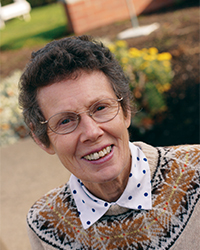
Chapple had few female colleagues among the faculty — there were only 16 within a faculty of 80, and no other women among the chemistry faculty — but the wives of male faculty members were welcoming and invited her to their events. No one warned her about the dress code for campus women, however. She recalls that one evening, she walked into the library and received incredulous stares from students. One young woman gasped, “Oh, Professor Chapple, we’re not allowed to wear trousers here!”
Chapple, a native of Britain, had attended all-girls’ schools before college, and her parents firmly believed that women should be able to do anything they worked toward, so she was unruffled by her own path-breaking. She taught her classes with vigor and in 1990 became Willamette’s first faculty member selected for an Oregon Professor of the Year award.
She also played tennis against men, hiked and climbed mountains, and ran in intramural cross-country races. “I was surprised when an alum came up to me and told me I had been a role model and inspiration for the female students,” Chapple says. “Young women were often told by their mothers that they shouldn’t try to compete with or beat a guy, but I never was!”
Chapple was dismayed, however, to find out that she and other female professors were being paid less than their male colleagues — a norm then at many colleges and other institutions across the country. She credits Willamette President Bob Lisensky (1974-80) for putting muscle into the process of shifting women’s salaries upward. The goal of parity didn’t reach fruition in the College of Liberal Arts until the 1990s, when Willamette instituted a step-system pay scale that determines salaries of both men and women professors.
In addition to moving toward an equitable pay system, Willamette’s administration also made it a priority to bring in more female faculty and provide them with a supportive environment. Professor Emerita Suresht Bald (pictured below) joined the politics faculty in 1982 and became one of the first female faculty members of color in the university. She credits deans William Berberet and Larry Cress for their efforts to change the faculty’s gender balance.
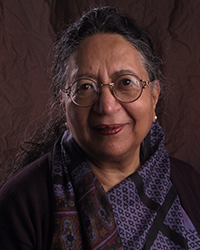
Still, change came slowly. “I was on a search committee during the ’80s for another department, and there was a very competent woman among the candidates,” recalls Bald, who was recognized as Oregon Professor of the Year in 2003. “She was excellent, from a good school, with a good record, and she was my choice. But the men on the committee — and they even had wives who worked — said no, that she would get married and have children and not be as productive as a man.”
Sally Markowitz joined the philosophy faculty in 1983, and Frann Michel joined the English faculty in 1990. Together with Bald, they formed the Women’s and Gender Studies Program (originally Women’s Studies Program) in 1992. The founding echoed efforts around the country to create university cultures that value women and tell their stories. Yet many of these stories are still missing in the public record, as Gallardo found when she paged through books about Oregon history, looking for information about Paulus and other female leaders.
WGS works to eliminate this gap by exploring the contributions and perspective of women. Areas of study include feminist theory, gender and society, and the history of women’s rights in the U.S. In the beginning, Bald, Markowitz and Michel taught all the core classes required for the program. Now, more than 20 professors from a wide range of departments design and teach classes for the program, and they can apply a feminist lens to their own discipline. WGS also explores the perspectives of all genders, such as non-binary or agender, and critically examines the ways in which gender shapes individual and institutional experiences.
“Traditionally in politics, for instance, we looked at the subject from the perspective of male power and how it’s used, not from the perspective of the people on whom that power was used,” explains Bald. “If you do not look at legislation and policy from the viewpoint of the downtrodden — and women are often the deprived group — you lose a great deal.”
The 1990s also saw a significant investment in science education for women. In 1995, lifetime trustee William B. Webber endowed a scholarship fund for outstanding women studying biology, chemistry, environmental science and physics at Willamette. Each year, the eight women receiving the scholarships develop lesson plans and, through the Willamette Science Outreach Program, bring science to fifth-grade classes throughout the Salem area. The Webber scholarships not only help the Willamette students learn to communicate science but also put a female face on science for a young audience.
“For many of these students, their idea of a scientist is someone who looks like Albert Einstein,” says Dolores Mlynarczyk (pictured below), the Willamette Science Outreach coordinator for 20 years. Mlynarczyk is also the university’s representative and Salem branch membership chair for the American Association of University Women, which has focused much attention on the dearth of women in the sciences.

The 1990s also offered a shining moment for Willamette women, albeit far from the classroom. In 1997, Liz Heaston ’99 joined the Willamette football team as a backup placekicker — and on Oct. 18, she became the first woman to play and score points in a college football game. The national press, including the New York Times and the L.A. Times, reported Heaston’s triumph, and she was named one of the 30 Most Influential Women in College Sports. Her jersey hangs at the College Football Hall of Fame.
Heaston explains that, like every other step forward for women, this one was decades in the making. In 1972, Congress passed Title IX of the Education Amendments, which stipulated that educational programs and activities that receive federal aid can’t discriminate by sex. One of the results was that schools all over the country had to support athletic activities and events for women, as well as for men.
“Twenty years later, that allowed me to walk on a football field and kick,” says Heaston, who was also a highly competitive soccer player at Willamette and is now a Washington state optometrist. “I also had a coach, Dan Hawkins, who was thinking outside the box and a team that was respectful.”
The push for equality continues
In a 1994 issue of the Willamette Scene, Mary Eyre, class of 1918, said that when she was a student, “There was some feeling that there were certain things that women didn’t do, but that feeling is encountered less at Willamette than in the general public.”
And that may still be the case. Betty Hart (pictured below) was one of a handful of women in the first graduating class of the Atkinson Graduate School of Management in 1976. She went on to work for local government, Northwest Human Services and then as controller of United Way of Mid-Willamette Valley until her retirement in 2010.
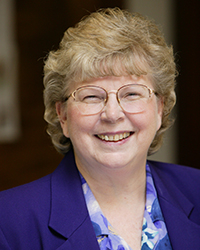
Hart entered Willamette when Helen Reddy’s “I Am Woman” was the anthem for many women eager to breach old boundaries. Hart excelled in her AGSM courses, and she carved an outstanding career — although in the early days she often noticed a shadow side to her rise. She wasn’t promoted as quickly as the men around her, even as she was given more and more responsibilities. Plus, men were sometimes credited with work that she had actually done.
“There are lots of ways women continue to be discriminated against in the workplace, sometimes so subtly that they don’t recognize it or know what to do about it,” Hart says. “That glass ceiling is hard to break. Still.”
Nonetheless, Willamette women continue to stride forward. In 2017, Sidney Gallardo was one of 368 women — compared to 307 men — to receive degrees from Willamette’s three colleges. She and her cohort have been lifted up by the university’s resources, as well as by the stories and examples of the women who came before.
Norma Paulus’ story inspired Gallardo — not only to believe in her abilities but to employ them to help others. She aspires to a career in politics or social justice. “Oregon would have been a really different state without Norma,” she says. “I like to think I carry a little bit of her spirit with me.”
This article was originally published in the fall 2017 issue of Willamette magazine. Kristin Ohlson is an award-winning author and freelance writer in Portland.

